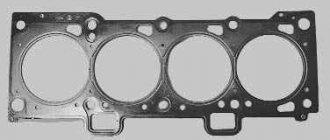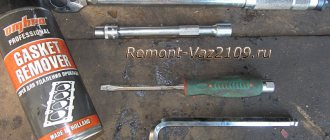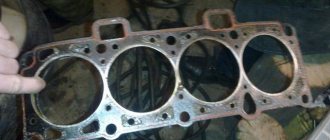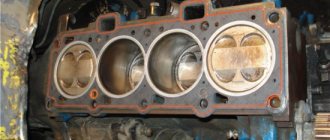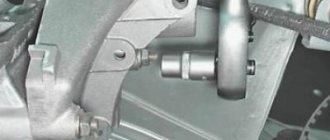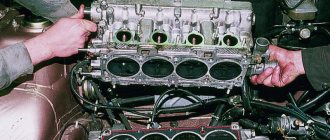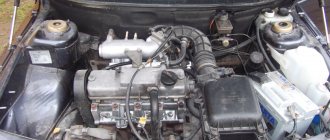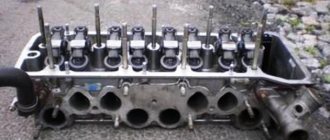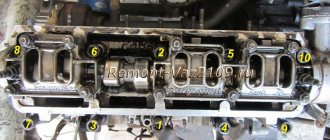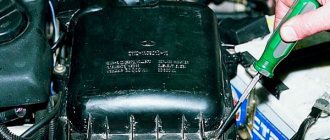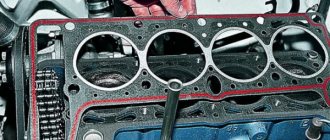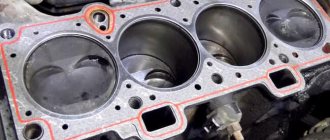03/02/2022 2,561 Cylinder block
Author: Victor
Malfunctions related to the operation of the cylinder head can lead to serious problems in the functioning of the engine. In this article, we will analyze in what cases the cylinder head gasket of a VAZ 2112 is replaced and how to perform this task yourself.
[Hide]
Frequency and reasons for replacement
According to official regulations, the cylinder head gasket of a VAZ 2112 engine can last 200 thousand kilometers. Usually, after traveling such a mileage, the service life of the seal is exhausted.
For what reasons may it be necessary to replace it:
- Natural wear and tear. Any part or machine assembly has a certain service life. Natural wear and tear cannot be avoided.
- Damage to the cylinder head, deformation or deflection. This may cause the gasket to break and hot coolant to get onto its surface.
- Boiling of the power unit. Regular driving of a car with an overheated engine will cause damage to the sealing element.
Head seal damage
Signs of replacement
By what “symptoms” can you understand that it’s time to change the BC head gasket:
- Leakage of motor fluid or coolant at the junction of the head connection with the block itself. If you see oil stains at the point of contact between the cylinder head and the cylinder head, diagnose the condition of the power unit.
- White smoke comes out of the exhaust pipe of the car, almost steam, uncharacteristic of exhaust gases. This indicates that coolant has entered the engine cylinders.
- The presence of foam in the area of the neck of the expansion tank in the engine compartment of the car. The substance foams as a result of exhaust gases entering the cooling system through a broken seal.
- The presence of greasy oily spots in the antifreeze, which indicates a poor connection and lack of tightness.
- A white coating has appeared on the engine fluid level dipstick. This indicates that refrigerant has entered the lubricant. This is usually the result of a damaged gasket.
What is this?
What exactly is this gasket?
This is a rubber element that has a certain elasticity. With use and wear, elasticity is lost. This reduces the quality and efficiency of performing the main task of the element - sealing the connection between the cylinder head and the cylinder block.
In order for the engine to work properly and without problems, the gasket must be installed efficiently and reliably. Ignoring its wear will lead to a serious reduction in engine life.
Signs of wear
If your old gasket is worn out, it won't be difficult to determine. There are several characteristic signs of loss of elasticity of a rubber element:
- White steam starts coming out of the exhaust;
- Traces of coolant or engine oil leakage appear at the cylinder head joints;
- Traces of oil appear in the coolant;
- An impressive amount of lubricant accumulates in the pan;
- Foam forms around the filler cap.
To check for the presence of steam in the exhaust gas, you need to remove the cap from the expansion tank with coolant and put the bag on the neck. If after a short period of operation of the power unit the bag inflates quickly, the gasket is worn out and therefore needs to be replaced.
Selecting a cylinder head gasket
Today you can find several types of cushioning products on sale:
- Asbestos gaskets. The main advantage of these seals is minimal shrinkage and good recoverability during operation.
- Metal. This type of product is one of the most reliable and high-quality, they have a long service life and are not so susceptible to damage as a result of overheating of the internal combustion engine.
- Non-asbestos. Typically used as repair kits. The main advantages of such gaskets are elasticity, heat resistance and elasticity.
The article number of the original product for the twelfth VAZ model is 2112-1003020. For the same brand of vehicles, high-quality gaskets are produced by the manufacturer Ajusa, product catalog number - 10144200.
User Sergei Tsapyuk published a video demonstrating the consequences of a damaged cylinder head gasket.
Features of repairing the cylinder head of the Lada Granta
The engine of the Lada Granta car has differences with the Kalina engine. The block head, in comparison with the Kalinovskaya one, has been increased in height by 1.2 mm. This is due to a change in the combustion chamber. Lightweight pistons installed. The timing belt has been modified and operates in a temperature range from minus 40 to plus 40 degrees. The declared belt mileage is up to 200 thousand kilometers.
The main feature of Granta cylinder head repair is the use of metal-ceramic seats. By car Kalina, 2114, etc. Cast iron saddles are used, which can be processed manually using a set of domestic cutters.
Machining cermet seats requires wear-resistant cutting tools. In order to successfully process them, the head is installed on the NEWENContour-BB machine, designed specifically for the rapid processing of seats and guide valves with digital control or manually with a Neway tool.
How to change it yourself?
Replacing the cylinder head gasket in a VAZ 2112 16 valves with your own hands is a rather complicated procedure. You need to change the head seal yourself if you have certain knowledge and experience.
If you read the instructions below, then taking into account all the nuances, you can independently replace the seal on a 16-valve VAZ 2112.
Tools and materials
So, if we change the gasket with our own hands, before performing the task we prepare the following:
- set of spanners;
- fresh engine oil and coolant if consumables are mixed;
- a torque wrench, it will be used to tighten the cylinder head bolts;
- container for collecting waste liquid;
- two screwdrivers - with a Phillips and a flat tip;
- clean rags.
The Basile Fomin channel published a video demonstrating the procedure for replacing the head gasket in a VAZ 2112 engine.
Algorithm of actions
Below we will look at how to remove and install the cylinder head in a VAZ 2112 car to repair the gasket:
- The car is driven into a garage with a pit or onto an overpass. You will need easy access to the bottom of the car.
- Open the hood of the car and turn off the power to the on-board network; to do this, use a wrench to loosen the bolt on the negative terminal of the battery and remove it.
- The coolant is poured into a pre-prepared container; to do this, the drain plug is unscrewed.
- If the replacement procedure is performed immediately after a trip, then you should relieve the pressure in the vehicle's fuel line. To do this, press down on the latch and disconnect the cables connected to the fuel pump.
- Then the intake manifold of the exhaust system is disconnected from the exhaust manifold. The thermostat is being dismantled. To do this, loosen the fastening clamps on the pipes and disconnect them.
- When the nuts securing the bracket are unscrewed, it must be moved to the side. The cylinder head with camshafts is dismantled. To do this, use a torque wrench to unscrew all the bolts securing the cylinder head. With the head, the housing of the bearing devices and the fuel rail are removed.
- After this, the engine fluid pressure controller in the power unit, as well as the DPKV, are removed. First, you must disconnect the connectors with wires from these devices.
- Loosen the tension roller screw and remove the timing belt. The toothed pulley on which the strap is mounted must be secured to prevent it from turning. Unscrew the fixing screw and remove it with the washer.
- Then, using the prepared screwdrivers, remove the disc from the camshaft.
- Disconnect all cooling system lines from the car engine, remove the antifreeze temperature controller in the engine. Remove all screws securing the head and washers. The device with the old gasket is removed. The surfaces at the point of contact of the head with the block are cleaned from residual sealing gum and dirt to prevent them from entering the power unit. Clean the threaded holes to remove any remaining coolant and lubricant.
- A new gasket is being installed along the guide elements. Please note that the hole for the intake of engine fluid must be installed as in the image below.
- Before installing the BC head, you must make sure that all marks on the shafts match.
- After installing the cylinder head, the bolts securing it are tightened. The screws are tightened in a certain sequence, as shown in the diagram - first the central parts, then the side ones. The stretching procedure is carried out in several stages. First, all bolts are tightened with a force of 20 Nm. Then the screws must be tightened with a torque wrench to 70-85 Nm. It is important that the moment of force is the same for all bolts. Next, each screw is tightened 90 degrees, and after all the parts are tightened, they must be turned again 90 degrees. To tighten, be sure to use a torque wrench, since it will not be possible to install the bolts correctly and tighten them without this tool.
- The procedure for assembling all components and connecting the lines is performed in reverse order. When the installation is completed, the valves are adjusted and the timing belt is tightened.
Dismantling the head after disconnecting all lines and sensors
When installing the gasket, ensure that the oil supply hole is installed correctly.
Tighten the cylinder head bolts on the VAZ 2112 engine according to this diagram
Cleaning valve channels
To remove any valve, you will need to remove the camshaft. All screws on the bearing housing must be unscrewed evenly and tightened with a force of 10 N*m. The hydraulic compensator can be removed with a magnet, and then the valve is desiccated by compressing the spring with a puller (see photo).
How to remove the valve
There may be carbon deposits in the valve channels. It is cleared:
- Flat screwdriver;
- Sanding felt.
Grinding is carried out as follows: a rubber pipe is placed on the valve, a paste with diamond chips is applied (one drop), then the valve is pressed into the channel and scrolled. It will also be possible to change the valve stem seals (2112-1007026). You can’t do this without a special puller.
Cap puller
On any car, including the VAZ-2112, cylinder head repair comes down to cleaning and checking, as well as correcting geometry defects. In the latter case we are talking about milling. The presence of cracks and chips is a reason for replacement, not repair.
A small photo report
A burnt valve is immediately visible.
One valve burned out in cylinder 2
Carbon deposits were found in each valve channel.
Carbon layer in the cylinder head channels
Repair: cleaning all channels, replacing the valve with lapping. Direct repair of the VAZ 2112 cylinder head will require several operations that require some special equipment. Of course, this is not possible at home, and car enthusiasts simply replace worn parts. Next, we will consider the process of repairing the block head, as well as some of the nuances associated with this work.
Stages of block head repair
Before proceeding directly to the cylinder head repair process, it is worth noting that the head must be completely disassembled and all the necessary spare parts purchased. Let's consider the process of complete overhaul of the cylinder head.
Washing and crimping
The process of washing automobile spare parts with hot kerosene
In order to wash the head, it must be completely disassembled, that is, all parts that can be easily removed must be dismantled. For a complete wash you need 12 liters of hot kerosene. At car services, this is done using a sprayer that supplies liquid under pressure. This way, all the dirt and remaining metal shavings are washed away. The washing is carried out until the cylinder head is completely clean.
The process of crimping the cylinder head
Crimping is a process in which the integrity of a part is checked. Pressure testing can be carried out in two ways, which are basically similar. The first is to close all the cracks and fill the part with water. If there is water leaking or leaking somewhere, then the integrity has been compromised and repairs are necessary. The second method is to close all the cracks and immerse the head in an aqueous solution. It will be immediately obvious where the part is depressurized. If the integrity of the head is damaged, it must be restored.
Removing saddles
Before moving on to the rest of the overhaul steps, the valve seats must be removed. In the best case, they will easily be knocked out of their seat, and if not, then you will have to use Russian ingenuity.
The valve is welded to the seat and knocked out of the seat
So, what to do if the valve seats do not come out? The solution is simple. It is necessary to weld a tube to them so that the working end passes through the channel of the guide sleeve and knock it out until the seat comes off the mounting mount. Of course, cracks may form on the seat ring or a piece may break off. After completing the procedure, it is necessary to inspect the place and, if necessary, weld it with argon welding.
Consequences of untimely replacement
Failure to comply with the timing of gasket replacement can lead to serious consequences:
- If the seal is damaged, the engine fluid will begin to mix with antifreeze. Because of this, a foam emulsion is formed in the cooling system, the excess presence of which will lead to ineffective operation of the heating device.
- Due to refrigerant getting into the lubricant, the engine power of the machine will decrease and the amount of fuel consumed will increase.
- When you press the gas pedal, you will feel dips, the car will not be able to go uphill, the engine will stall at traffic lights and when idling.
- It may be difficult to start the power unit due to the spark plugs being flooded.
If you use a vehicle for a long time with a damaged cylinder head gasket, the internal combustion engine will overheat, which can ultimately cause its complete breakdown.
Articles
The gasket costs pennies compared to the labor of replacing it.
Before you start replacing the gasket, you should purchase this gasket. Although any car store will select a suitable spare part for you, it is better to know its part number. The most suitable gaskets for the VAZ-2110 are:
- The original VATI gasket, which has the article number 21083100302022.
- Part VICTOR REINZ. This item is of higher quality than the original. Its article number is 613666000.
- TRIALLI gaskets, which have the article number GZ.
It’s better to immediately buy a better quality spare part than to bother with disassembly again later.
Video “Visual instructions for replacement”
You will learn how to change the cylinder head gasket yourself in a VAZ 2112 from a video filmed by the ClubUazFan channel.
Do you have any questions? Specialists and readers of the AUTODVIG website will help you ask a question
Was this article helpful?
Thank you for your opinion!
The article was useful. Please share the information with your friends.
Yes (100.00%)
No
X
Please write what is wrong and leave recommendations on the article
Cancel reply
Rate this article: ( 5 votes, average: 5.00 out of 5)
Discuss the article:
When is it time to change?
Even an experienced specialist will not give you the answer to this question. This is because when certain elements fail, the cylinder head of an 8 or 16 valve engine is repaired, rather than replaced.
The only reason for replacing the head can only be its deformation, which does not allow the unit to be adjusted correctly.
In addition, these may be cracks that, for one reason or another, cannot be eliminated. In all other cases, the unit is repaired.
Cylinder head of VAZ 2110 disassembled
Let's move on to the cylinder block
We remove the pallet. Rotating the crankshaft as it is convenient for us, unscrew two bolts on each connecting rod cap. We use a TORX E10 head for this.
We take out the pistons along with the connecting rods. To do this, use the wooden handle of a hammer to press the connecting rod from below and lightly tap it to knock it up. We remove the old liners and buy new ones of the same size according to the markings on them. Here is another stone in AvtoVAZ’s garden, the owner has never climbed into the car from the interior or into the engine, but three pistons were of group “B” and one was “C”. It turns out that at the factory they re-sharpened one cylinder a little and simply put an enlarged piston there, no words. There are no options, we take group “C”, don’t sharpen the engine because of this. We will not touch the main liners either.
We buy a new piston group that does not bend the valves, connecting rods and connecting rod bearings.
Eliminating longitudinal play of the crankshaft
It was noticed on this motor. To eliminate it, replace the thrust half-rings. Standard and repair sizes are available. We take the first repair size, if they are too tight we sand them down a little. We unscrew the middle main bearing and gently push it with a screwdriver and move the half rings. The mark on it is in the form of three serifs, shown below.
When the half ring comes out a little, turn the crankshaft, it will push it out. There are two types of half rings: white at the front and yellow at the rear; the grooves on them should point towards the crankshaft cheeks.
We install them as we removed the new half rings; if they go in with great effort, you can grind them a little on a small abrasive stone, but not from the side of the grooves. Checking the play.
We tighten the main bearing with a torque of 8 kgf*m.
Assembling the piston
There is an arrow stamped on the top of the piston; it should be directed towards the front of the engine. And there are marks on the connecting rod that should look the same way.
Don't get confused!
We insert one retaining ring into the groove on the piston. We insert the connecting rod into the piston and, having lubricated the connecting rod and the piston pin with oil, insert it into place. Insert the second retaining ring. Although this operation seems simple, it will take some pains. We inspect the assembled structure; all retaining rings must be clearly in their grooves, otherwise a ring that has jumped out while the engine is running can cause a lot of trouble.
After assembly, you need to break off the connecting rod bearing cap, since the connecting rod is made in one piece. It's like that on our cars. First, unscrew the bolts. We insert the connecting rod into the cleats at the level of the mark shown in the figure with the black arrow and lightly clamp it, then break it off with a slight movement of the hand. The first time is very scary. We put the cover in place and tighten the bolts so as not to mix it up in the future.
Checking the thermal gap in the piston rings
We lay out each set of rings for each cylinder.
In the future we will not change their places.
In turn, we insert each ring into its own cylinder and push it a little with the piston approximately to the middle.
We measure the gap with feeler gauges.
Nominal clearance: 0.25 - 0.45 mm.
The maximum clearance for all is 1 mm. But this already smacks of waste.
Installing new rings
First, install the oil scraper ring expansion spring, then the ring itself. The oil scraper ring lock should face the opposite direction of the spring lock. Then we install the lower compression ring and finally the upper compression ring.
The inscription “TOP” must be stamped on the rings; it must face up.
The rings in the piston grooves must rotate easily.
